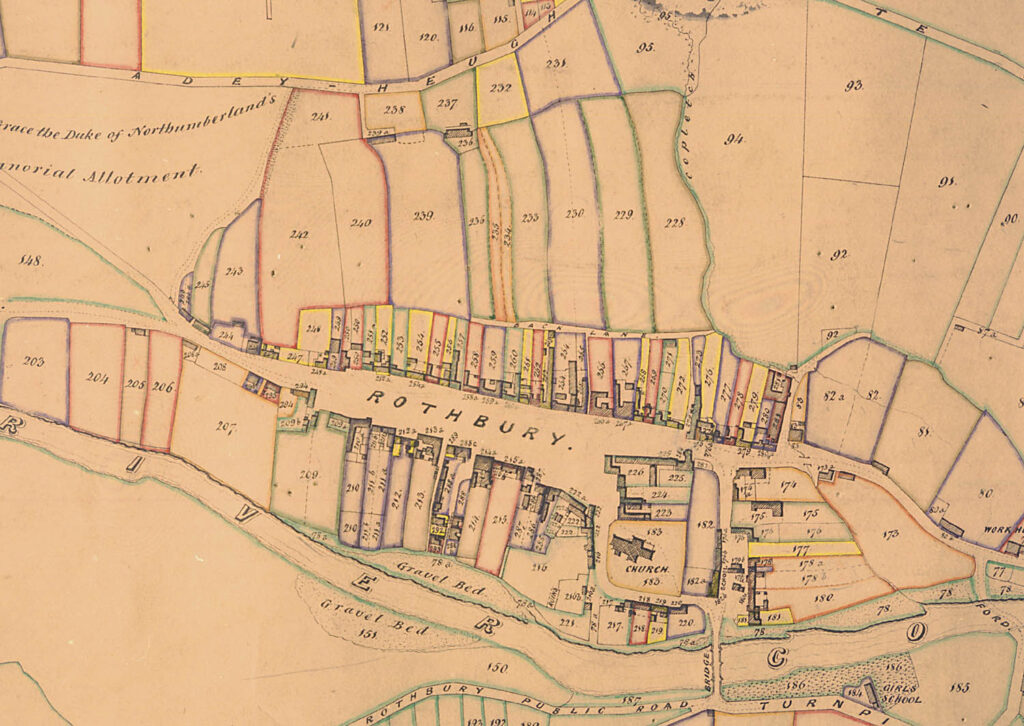Why were they created?
Reference: DT 400/M Rothbury
CONTEXT
Burgage plots did not have any labour services attached to them; they were freehold land. Burgesses had to pay a small money rent to the lord each year, but could then buy or sell the land as they liked. This meant that burgages were very attractive, but could only be bought by people that had enough money to be able to buy them.
By placing the plots near the marketplace and along the main roads, the lord of the manor made these plots especially attractive to tradespeople – people who made and sold goods. The documents in the using documents section mention a glover in Hexham* and a cordwainer (shoemaker) in Alnwick as holding burgages.
Manorial lords wanted to attract these people to their settlements to encourage trade and the develop the money economy.
*The processing of fine leather and making it into gloves and saddles were the main trades in Hexham.
GIVE IT A GO
- Look at the map of Rothbury on this page. Can you identify the burgage plots?
- Can you identify any main roads or a marketplace on the map? Can you see evidence of the burgage plots located nearby?
- Discuss why it would be attractive to tradespeople for their shops to be located near main roads or marketplaces.
- Choose another town to compare this map of Rothbury with. Can you locate the marketplace, main roads, and nearby burgages?
OTHER ONLINE RESOURCES
Burgages
Burgage Plots website, fantastic source of information about all aspects of burgage plots: www.burgageplots.info
Burgage Plots website, page with links to other online sources: https://www.burgageplots.info/links
Amble and District Local History website, page about Warkworth (from JC Hodgson A History of Northumberland 1899): https://www.fusilier.co.uk/warkworth_northumberland/warkworth.htm
Morpeth Conservation Area Review website, page about town’s heritage: https://morpeth-conservation-area-review-luc.hub.arcgis.com/
Royal Berkshire History for kids website, page about burgage plots (includes diagram): http://www.berkshirehistory.com/kids/burgage_plots.html
Marian L. Wilson Plan analysis of the medieval boroughs of Northumberland PhD thesis, Edinburgh, 1989 (PDF download): https://era.ed.ac.uk/bitstream/handle/1842/6884/294040.pdf?sequence=1
Manorial records
Cumbrian Manorial Records website from Lancaster University (includes glossary of manorial terms):
https://www.lancaster.ac.uk/fass/projects/manorialrecords/manors/whatis.htm
Digital Humanities Institute website (Shffield University), pages about Conisbrough Manor (includes glossary of manorial terms): https://www.dhi.ac.uk/conisbrough/index.html
Manorial Documents Register database from The National Archives: https://discovery.nationalarchives.gov.uk/manor-search
Hexham
Hexham Local History Society website, page with gallery of leather working images: https://www.hexhamhistorian.org/historic-hexham/photograph-archive/photo-archive-choices/hexham-choices/industry-and-transport-gallery/leather-gallery/


